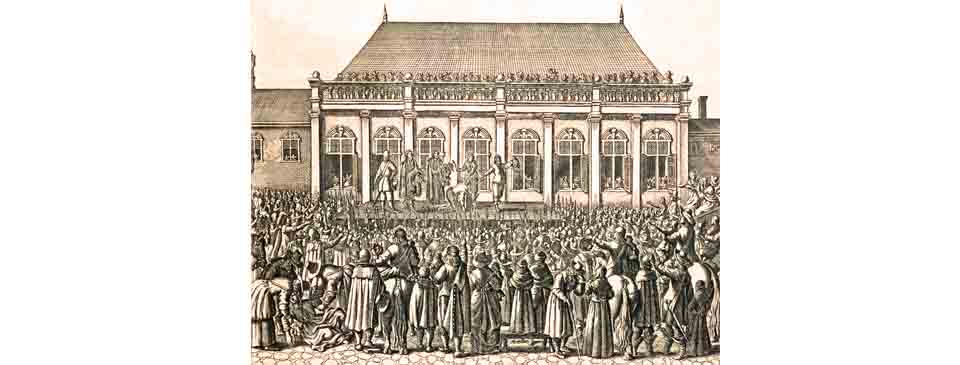The Trial and Execution of King Charles I

Pictures showing the execution of Charles I at Banqueting House were forbidden in England but soon began to appear on the Continent. The earliest engraving appeared several weeks after the event in the book ‘Theatrum Tragicum’, published in Amsterdam. A woman in the bottom left of the picture feints as the assistant executioner holds aloft the severed head of the King.
On Monday the commissioners, 70 by that time, carefully rehearsed Bradshaw in Westminster’s Painted Chamber before the resumption of the trial. Charles began to give a speech, which he had prepared the day before, explaining why he could not acknowledge the authority of the court. Bradshaw soon interrupted him, requesting him to give an answer as to whether he would answer the charge. To that Charles replied:
By your favour, Sir: I do not know the forms of the law. I am not a lawyer. But I know as much law as any gentleman in England and – by your favour, Sir – I know that I am pleading for the liberties of the people of England more than any of you. Any man brought before a court may demur against the proceedings. And if Power without Law may make Law, I do not know a subject in England who can be sure of his life or anything he can call his own.
An argument between Charles and the court followed with neither side budging from their position. Finally, Bradshaw dismissed him, saying: “The next time you are brought here you will hear more of the pleasure of the court and, it may be, their final determination”. Then a great shout of “God save the King” came from the assembled people. That so enraged Colonel Hewson that he spat in the King’s face, shouting “Justice! Justice! Upon the traitor”. Charles replied: “Well, sir. God hath justice in store both for you and me”.
Proceedings on the third day of the trial were very similar to the day before. The commissioners met in the Painted Hall on Wednesday to discuss the situation. Their decision was that they should end the matter by passing sentence.
On Saturday 27th Charles was brought before the court. An argument ensued between the King and Bradshaw as to who should be allowed to speak. Bradshaw launched into his prepared speech but was interrupted by Lady Fairfax shouting from the gallery: “It is a lie. Not half nor a quarter of them. Oliver Cromwell is a traitor”. Bradshaw again attempted to continue with his judgement speech but Charles demanded to meet in the Painted Hall to give his defence. There was disagreement between the commissioners. The King was taken to Sir Robert Cotton’s house at Westminster while the commissioners debated the point. John Downes spoke against execution but he was fiercely reprimanded by Cromwell and no other commissioners backed his opinion.
The commissioners returned to Westminster Hall and called for the King. They refused his request to meet. Bradshaw gave a long speech setting out the judgement against Charles. The King requested the right of reply but was refused. The clerk then read out the sentence of the court, which ended:
For all which treasons and crimes this Court doth adjudge that the said Charles Stuart, as a tyrant, traytor, murtherer and publique enemy to the good people of this nation, shall be put to death by the severing of his heade from his body.
Charles attempted to speak but Bradshaw instructed the guards to lead him away.
The death warrant named the King as “Charles Stuart, King of England” rather than his full title and was signed by 59 – less than half – of the Commissioners. It specified he should be executed “in the open street before Whitehall”.
Charles spent his last days at St. James’s Palace. On the bitterly cold January morning of 30th January, he took his last communion before daybreak. He was then led across St. James’s Park by his guard Colonel Thomlinson and a detachment of soldiers, together with William Juxon, Bishop of London (the former Lord Treasurer, who was to become Archbishop of Canterbury after the Restoration), and the King’s gentleman-of-the-bedchamber Sir Thomas Herbert. They crossed over Holbein Gate to the eastern side of Whitehall Palace.
While Charles waited in his bedchamber at the palace there was disagreement between the commissioners. Colonel Huncks refused to sign the death warrant and only minutes before the execution his place was taken by Colonel Hacker.
That being done, in the early afternoon Cromwell dispatched Hacker to fetch the King. Charles presented Thomlinson with his gold toothpick case. The party then continued through the palace to Banqueting House. Charles and the Bishop passed out of a first-floor window, or possibly through an opening that had been specially made for the occasion, onto a platform erected in the public street that ran from Charing Cross to Westminster between the Banqueting House and the Tilt Yard. There the King addressed the great crowd to tell them he was dying as a “martyr of the people”. His final act was to hand his cloak and the ‘Great George’, the large bejewelled Order of the Garter which hung around his neck, to Bishop Juxon to whom he said the single word: “Remember!” Then he was beheaded. It was reported that there was a large groan from the assembled people, in contrast to the traditional cheers that normally marked such an event, although soldiers clapped their approval. The assistant executioner held up the head and exclaimed: “Behold the head of a traitor”. The troops then quickly dispersed the crowd and the scaffold quickly dismantled.


